Retrofitting Homes for Storm Surge Protection
As extreme weather becomes more frequent and intense, storm surge is a top of mind concern for many homeowners. Storm surge, a powerful rush of water caused by hurricane or tropical storm winds, can cause severe flooding and structural damage in coastal or inland communities. Fortunately, retrofitting makes it easier to protect your home from this climate threat.
Essential Retrofitting Strategies
Storm surge, the rapid rise in sea level during tropical storms and hurricanes, poses a severe risk to coastal areas and other vulnerable regions. With the potential to cause extensive flooding and structural damage, homeowners must take these proactive measures to handle the storm surge cleanup and initiate a successful recovery process.
Elevate Your Home’s Foundation
One of the most effective ways to reduce the threat of storm surge is to elevate your home’s foundation. Hire a professional contractor to evaluate the property and implement a suitable elevation method. Not only will this protect your home from flooding, but it could also reduce your insurance premiums in the long run.
Reinforce Doors and Windows
Storm surge can breach your home through a weak or unstable access point in the doors or windows. Installing impact-resistant windows and doors will prevent this from occurring. Storm shutters will offer an extra layer of protection as well. You’ll also need to reinforce the garage door with a bracing kit to protect it from water or other debris.
Seal and Secure Openings
Water can seep in through even the smallest crevices, so be sure to seal all openings. Apply waterproof sealant to the windows and doors, and seal off any gaps where wires or plumbing enter the home. Next, install backflow valves on sewer lines and septic tanks to prevent sewage backup in the event of a flood. Some of these tasks can be DIY projects, but a professional can identify less obvious access points for maximum protection.
Outdoor Safety Measures
Storm surge protection should not be limited to just your home itself. The surrounding landscape and other outdoor elements can also affect the property’s resilience. Turn your home’s exterior into a robust first line of defense against powerful waters and strong winds.
Modify Your Landscaping
The following landscape modifications can help divert water from your home’s interior. Make the following improvements and consult with a landscape architect to help you design an effective water management system tailored to your specific needs.
– Grade your lawn to slope away from the house
– Install a rain garden to absorb excess water
– Use permeable materials for driveways or other walkways
Secure Outdoor Items
When storm surge hits, outdoor items can become dangerous projectiles. To avoid this, store all patio furniture, outdoor grills and kitchen equipment, potted plants, or garden decorations inside before the storm makes landfall. Larger items such as fuel tanks or sheds require professional anchoring services to secure them against hurricane-force winds.
Building Material Upgrades
When performing home renovations or repairs, choose flood-resistant materials. Install closed- cell spray foam insulation, water-proof drywall, and ceramic tile or vinyl flooring. A professional remediation company can help you determine the best materials and ensure optimal installation, to safeguard your home from potential water damage.
The Value of Professional Assistance
While certain retrofitting tasks can be completed on your own, a professional service will ensure maximum storm surge protection. This can save you time and money in the long run:
– Conduct a thorough risk evaluation of your property
– Develop a customized protection strategy
– Ensure all modifications meet local building codes
– Implement complex solutions like home elevation
– Perform continual maintenance and inspections
Reclaim Your Home from the Threat of Storm Surge
Despite the most vigilant efforts to protect your home, storm surge can still wreak havoc, so act quickly to recover from the damage and minimize further issues. While you can do some of the initial storm surge cleanup on your own, extensive water damage often requires professional assistance. Disaster restoration experts have the knowledge and equipment to handle these complex situations for an efficient, successful recovery process.
- by Matt Watts



